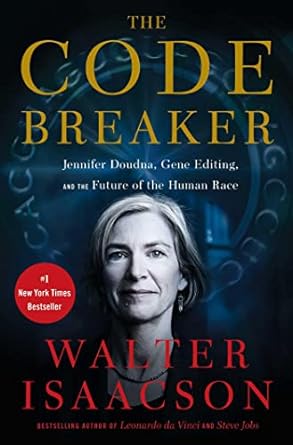The Code Breaker Jennifer Doudna, Gene Editing And The Future Of The Human Race | Book by Walter Isaacson

Walter Isaacson is a American journalist a distinguished career in roles such as Aspen Institute, CNN, and Time magazine, best known for his biographies on influential figures like Albert Einstein and Benjamin Franklin. His ability to depict narratives into stories solidified his reputation as a figure in the world of journalism and biography.
A NEW 🌊 IS APPROCHING 🏄
Review By: Joel Lovely
Who should read this book ?
Readers who are interested in potential trends in future enterprise, discovery, and human advancement.
Before:
I picked up this book after seeing 4.7 / 5 on audible, with no prior knowledge in the field.
After:
This book is truly enlightening, having been published in 2021, making it relevant to the future we may be headed towards. Not only has this book greatly impacted me, but it has also sparked a profound shift in my perspective on the ethical dilemmas presented in its climactic moments.
Part 1:
The book delves into the origins of Jennifer Doudna, who was born in Washington DC but later moved to Hilo, Hawaii, where her father worked as a professor of English at a small community college. Curious about pursuing a career in science, her idol is Rosalind Franklin, one of the four scientists credited with the discovery of the double helix structure of DNA.
Fast forward to the 1990s, the United States Government initiated the “Human Genome Project,” an endeavor that would span 13 years and cost 3 billion dollars in pursuit of genetic discovery. Despite significant investment, the project achieved limited success, prompting scientists to seek alternative avenues for insights. It was during this time that Jennifer Doudna turned her focus to RNA.
Part 2:
Making significant discoveries, she becomes a leading scientist in the field of RNA and its associated studies, gaining traction. She was on the verge of discovering something big called CRISPR (Clustered Regularly Interspaced Short Palindromic Repeats). Based on bacteria’s evolutionary defense mechanism, she found repeated letters of DNA followed by a snippet of virus DNA, which was used to remember invading viruses carried out by enzymes. Unknowing about enzymes, Emmanuelle Charpentier, a French biologist, would join her. Later, publishing a journal in Science about CRISPR’s sophisticated system that had shown gene editing in prokaryotic cells with a simple three-component system (RNA, TRACER RNA, and Cas9). With a drama-packed race filled with conspiracies, Feng Yang and the institution of the Broad Research of MIT and Harvard would race to use the fundamentals of CRISPR and later beat Doudna in becoming the first to publish a journal to Science about CRISPR in human cells.
Part 3:
Patent wars between Feng Yang and Jennifer Doudna ultimately reached a stalemate. However, scientists and researchers continued to build upon CRISPR technology, leading to significant breakthroughs. For instance, Emmanuelle Charpentier developed a cure for sickle cell anemia, showcasing the potential of CRISPR in medical advancement.
Yet, controversy arose with the actions of Chinese scientist He Jiankui. On November 25th, 2018, He Jiankui shocked the world by announcing that he had genetically modified two babies (Nana and Lulu) using CRISPR technology, a move that was widely condemned for its ethical implications. He Jiankui was subsequently imprisoned due to his involvement in unethical practices surrounding the creation of the world’s first genetically modified babies.
Part 4: CRISPR has evolved significantly during the pandemic, making substantial contributions to science. Continuously evolving, new enzymes such as Cas-12, Cas-13, and Cas-13D, along with cutting-edge technologies, are currently in development. As the book concludes, it hints at the impending conclusion of new advancements yet to unfold, leaving readers eager to witness the next chapter in CRISPR’s remarkable journey.
Conclusion:
A new technology seems to be emerging, much like the computer revolution that preceded us, which seems poised to change life as we know it.